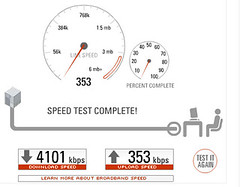Bandwidth: Why Fast Is Important in a Global Economy
Bandwidth is the basic foundation for Internet traffic as a connector to everything important in our lives. Whether it is basic bandwidth for connecting to family and friends, or a super fast highway for global reach and competitiveness in the business world, bandwidth constitutes the speed at which
Leonard Grace

- Image by Xuli via Flickr
Bandwidth is the basic foundation for Internet traffic as a connector to everything important in our lives. Whether it is basic bandwidth for connecting to family and friends, or a super fast highway for global reach and competitiveness in the business world, bandwidth constitutes the speed at which we connect as a global presence within the expanding sphere of Internet communication.
Bandwidth: “defined as the speed at which data is transferred over an electronic communication device like a server. The units of measurement are based on the maximum transfer rate and measured in either Kbps or Mbps.”
- Kbps: (kilobits per second) – “A measure of 1000 bits of information transferred per second.”
- Mbps: (Megabits per second) – “A measure of approximately one million bits of information transferred per second.”
To understand why bandwidth is important to all Americans, including personal and business uses, we must understand the different types Internet traffic. We also must understand U.S. bandwidth rankings from a global perspective and how successful infrastructure upgrades can ensure fast, secure and easily accessible information sharing in a globally competitive economy.
- Dial-up – the lowest speed of bandwidth providing 56 kbps connection normally used for e-mail only as transferring large files are impossible.
- DSL – much faster than dial-up and has plenty of bandwidth to spare. Is good for large file downloads like video, typically provided by a modem and phone line installation.
- Cable – provided by Cable TV companies with a Hybrid-Fiber Coax connection. It provides speeds faster than DSL which typically range from 4Mbps to 8Mbps. Increases speeds of large download and uploads.
- Fiber – The future of the Internet rests with the fiber connection. Fiber must be run to your home or business and provides speeds of 30Mbps download and 5Mbps upload.
It can be seen in the accompanying graph, (Courtesy Akamai 2010), that global connection speeds are much higher in countries like South Korea, Hong Kong, Japan and many other countries. In fact, the US is ranked 11th in the Top 10 Countries – Average Connection Speed –Q4 09.
From an economic standpoint, the US must move to change its bandwidth competitiveness on a global scale. Many conclude that a free and competitive business model of the US has kept us behind the curve in Internet speed, access and adoption. Enter the National Broadband Plan, developed by the FCC, to change our status in all aspects of the Internet. A comprehensive road-map that directs the adoption of Internet standards to take us through the next 10 years to improve speeds, accessibility, and universal adoption for both business and personal use.
Uses
The uses of fast bandwidth can be chronicled in forward thinking experts who realize to inevitable potential to change the business and personal use of bandwidth can change our lives, from energy conservation through monitoring and applications , remote medical monitoring and diagnosis, B2B applications to strengthen collaboration, and remote educational advances through e-learning. These applications all have the potential to advance the U.S. in job creation and a global competitive advantage.
Infrastructure Upgrades
Unfortunately, due to a lack of wide-spread competition within network provider footprints our Bandwidth does not compare to a more government oversight approach adopted in other developed nations. While the FCC is looking to change the dynamics in competition, while mandating future bandwidth speeds in measureable increments of time; it will be incumbent on Internet Service Providers to upgrade their networks sooner rather than later.
- The Cable Industry has approached Internet upgrades with the advent of Docsis3 (Data Over Cable Service Interface Specification), permitting the addition of high-speed data transfer over a Cable TV system.
- Verizon is accomplishing the task by upgrading to FIOS (Fiber-to-the-Home) approach, using the future or (end-game) solution, which most operators will move toward eventually.
- AT&T has adopted the U-Verse solution which uses IP (Internet Protocol) to deliver its high-speed Internet service.
The bottom line remains that without a comprehensive plan by Internet Service Providers to continue an aggressive infrastructure improvement strategy, the US will continue to lag behind globally in bandwidth speeds without proper upgrade incentives, which could put us at a distinct disadvantage in a fast growing global economy.
Related articles by Zemanta
- State of global internet revealed (bbc.co.uk)
- Broadband Tariffs: The Significant Gap Between Residential and Business (circleid.com)
- Ask HN: Anyone hosting their site on servers in their garage? (news.ycombinator.com)
- Canada: Get Ready for Broadband Bandwidth Tiers (markevanstech.com)











Member discussion